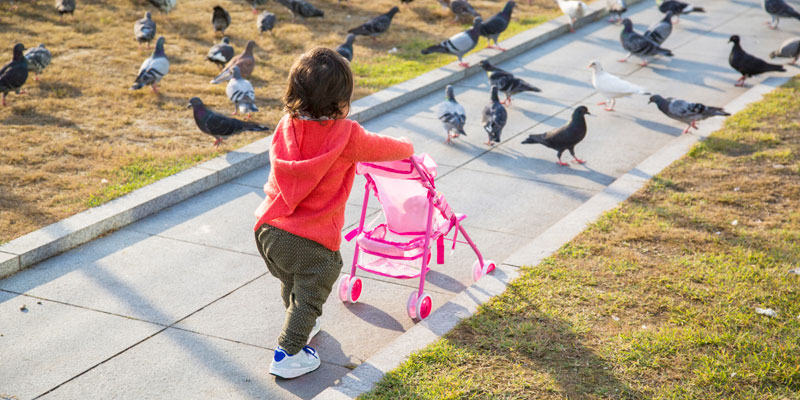
Toddler Multi-Tasking: Your Child Learning to Push, Pull, and Carry
With the ability to walk often comes other complementary skills. Think about the coordination it takes for a baby to walk and carry something at the same time, and yet, children have the motivation to do it! Pushing and pulling activities can also be favorites at 12-18 months old.1
With improved Active, Coordinated Movement abilities, in addition to his early walking skills, your baby probably enjoys playing with push toys,1 like a baby stroller, toy lawnmower, or play vacuum cleaner. These toys will help support his balance and walking skills as he gains more practice walking, as well as give him more confidence with this new skill.2 Look for toys that have a push bar and are sturdy enough to not fall over easily.3 Or, instead of a toy, consider offering your baby a large box or laundry basket and watch him have fun pushing his “grocery” cart around the house, putting objects into his cart as he shops and plays market!
(SPECIAL OFFER: Sign up for Playful Bee’s Bee Well developmental learning program to give your baby the best start in life. The first 10,000 children enroll for FREE! Sign up today.)
At this age, many children also enjoy using pull toys, dragging them behind them as they walk.1 This may extend to unintentional pull toys, so don’t be surprised if you see your baby dragging his prized teddy bear behind him everywhere he goes! To encourage his interest in pulling as well as pretend play, try giving him a variety of pull toys to play with, such as a dog on wheels with a pull string used as a “leash.” As he matures, your baby will eventually graduate to pulling larger toys, such as small wagons with his toy friends riding inside.
As your baby’s coordination skills improve, he will be able to multitask by walking and carrying objects well. You can help him develop this ability to carry objects while walking by asking him to help out with certain household chores.4,5 Encouraging him to put away his toys in their proper storage boxes is a great way to practice carrying as well as organization. Asking him to help put his dirty clothes into the laundry hamper or put the groceries away into the pantry also helps support his ability to coordinate muscle movements and build his self-help skills. According to research by Marty Rossmann, emeritus associate professor of family education at the University of Minnesota, children who are actively involved in household chores achieve greater success by their mid-20’s compared to their less involved counterparts. They develop a sense of responsibility, competence, self-reliance, and self-worth that stays with them throughout their lives.6 However, when including your baby in these everyday tasks, be sure to adjust his tasks to his current abilities, making sure that he doesn’t handle objects that are too heavy, fragile, or big.
Play Tips:
Do you want to know how you can support your baby’s development of these Active, Coordinated Movement skills at this age? It’s easy! Read on for some simple tips to incorporate into your daily play time together.
- Offer your baby a variety of push and pull toys to play with.1,3 Keep your baby interested in walking practice by offering him different push and pull toys, such as an animal on a string, a lightweight wagon, a toddler shopping cart, or a baby doll stroller. The best part about many of these toys is that they also encourage your baby to pretend play, which will become an increasingly important part of his learning as he grows.
- Provide a safe and unobstructed space to play in. Because these push and pull toys focus on developing walking skills, make sure to give your baby lots of room to play that’s free of hazards (e.g. open stairs going down), fragile objects (e.g. glass vases that can be knocked over), and obstructions (e.g. furniture). The purpose of these pushing and pulling activities is to encourage your baby to practice his walking skills as much as possible, so give him plenty of space to roam around!
- Include your baby in daily chores that focus on hand and walking coordination.4,5 By placing items in their proper places, your toddler will develop the muscle coordination required to carry objects while walking, as well as become familiar with household organization and order.
(SPECIAL OFFER: Sign up for Playful Bee’s Bee Well developmental learning program to give your baby the best start in life. The first 10,000 children enroll for FREE! Sign up today.)
Developmental Milestones:
Has your baby achieved the following Active, Coordinated Movement developmental milestones yet? If yes, check off all the skill(s) she has already mastered to date using Playful Bee’s developmental milestones tracker. It’s absolutely FREE and easy to use, just click HERE!
- Pushes, pulls, and carries toys while walking.
Sources:
1Maryland State Department of Education (2010). Healthy Beginnings: Supporting Development and Learning from Birth through Three Years of Age.
2What to Expect. Walking Dos and Don’ts. What to Expect. Retrieved February 5, 2014, from http://www.whattoexpect.com/toddler-walking-tips.aspx.
3Greene, Alan (2010). Baby Walkers. Dr. Greene. Retrieved February 5, 2014, from http://www.drgreene.com/qa-articles/baby-walkers/.
4Denham, Susanne A. When Can My Toddler Start Doing Chores, and What Kinds Are Appropriate? BabyCenter: Expert Advice. Retrieved February 5, 2014, from http://www.babycenter.com/404_when-can-my-toddler-start-doing-chores-and-what-kinds-are-ap_6833.bc.
5Weldon, Laura G. (2012). How Kids Benefit from Chores. Wired. Retrieved February 5, 2014, from http://www.wired.com/geekmom/2012/06/chores-benefit-kids/.
6University of Minnesota (2002). Involving Children in Household Tasks: Is it Worth the Effort? University of Minnesota College of Education and Human Development: ResearchWorks. Retrieved February 5, 2014, from http://www.cehd.umn.edu/research/highlights/Rossmann/.
Playful Bee
Latest posts by Playful Bee (see all)
- Have a Super Fortune Cookie Friday! - February 9, 2018
- All Kinds of Shapes: Your Child Is Learning Simple Shapes, and Drawing Them Too! - November 13, 2017
- Fishing for Sneakers: Create your own Hand-Eye Coordination Fun - November 11, 2017

+ There are no comments
Add yours